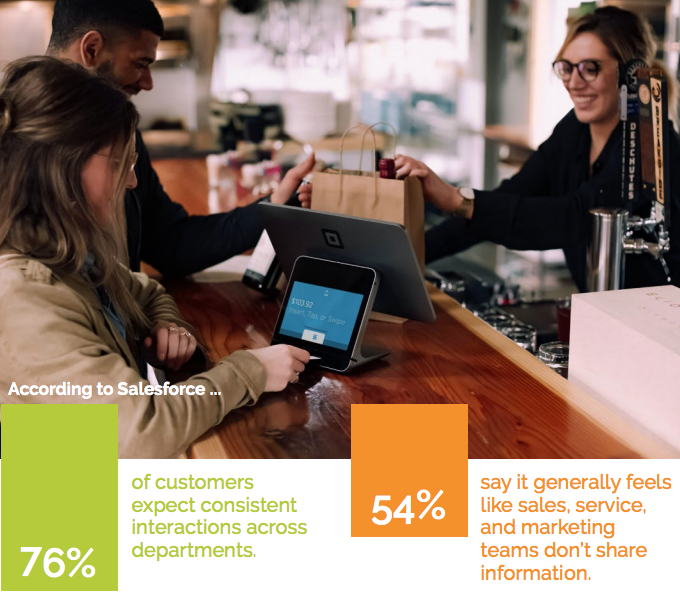The age of ‘Digital Self-Serve’ enables trade credit sales channels
Your customer’s decisions – what products to buy, services to use or providers to engage with – are heavily influenced by the ratio of pleasure versus pain in their user experience.
As technology advances, companies have increasingly turned to multichannel strategies to reach potential customers, who can also be credit borrowers. But, in trying to reach as many customers as possible, how focused have we been on the customer’s experience in doing so? Customer pain, customer pleasure, or a mix of both (depending on which sales channels they choose to engage)?
Open for credit
If you have already been successful in your holistic omnichannel approach (which combines a variety of lending channels – from web to instore, from sales reps to call centres – into a seamless customer-centric journey) then, the next evolution in your strategy is customer convenience. It has got to be ridiculously easy for customers to do business with you, wherever they are and whenever they want to purchase. Optimising convenience and reducing friction wherever possible.
What is Omnichannel?
The key word here is seamless. Omnichannel provides a seamless, continuous customer experience across any device or location from which a customer wishes to engage. The experience becomes not just about one engagement at one point in time but about every experience your customer has with your brand at every single touchpoint across all your channels.
Omnichannel is no longer an aspiration but a key requirement to remain competitive as a credit provider.
By creating continuity between any device or location where customers choose to engage, companies can strengthen their foothold and gain new business opportunities without delay.
Are you a multichannel lender or an omnichannel lender?
Multichannels use multiple outlets to communicate and work with customers. You probably have a Sales Team who nurture sales through their activity. This would be quite different from the Website Team who are tasked with website traffic, retention and conversions. Each team focuses on their channel. However, what may not be considered thoroughly with this approach is the customer.
On the other hand, in the case of omnichannel those different channels are linked together.
Multichannel puts channels at the core of the strategy, while omnichannel puts the customer at the core where customer experience is effortless and seamless. For example, while they may start a credit application with one channel (say, online) they can easily move across to another channel (say, in store) without having to repeat themselves each time.
According to Salesforce 76% of customers expect consistent interactions across departments. Yet 54% say it generally feels like sales, service, and marketing teams don’t share information.
That’s not holistic. And it’s not omnichannel.
A multichannel experience can be like talking to multiple people at a company – each with their own style, personality and understanding of the task. Meanwhile an omnichannel approach is more akin to dealing with one highly capable individual who effortlessly handles all your needs making it super convenient and easy for you!

Ultimately, omnichannel strategies aim to deliver a consistently great customer experience no matter how your customer may engage. Using automation, businesses have an easy opportunity to provide a holistic customer journey and quality engagement with their consumers across all channels.
Let’s explore four sales channels that are perfect for B2B lenders to maximise opportunities for convenient credit:
Channel 1 – Field Sales Reps
Field Sales Reps help you reach potential customers more efficiently by bringing your products to their doorsteps. This is old hat. What’s new is the Sales Rep being able to offer credit there and then, the Customer being approved for credit there and then and the credit derived from this transaction being attributed to the Sales Rep.
🤔 Do you have a way to monitor credit approvals from your Sales Rep channels
so you can attribute this sale to them?
Channel 2 – On Location, In-store or at Point of Sale
So, if you are paying a sum for that bricks and mortar store it’s definitely worth making sure that you are set-up and fully equipped for trade credit lending. And not only from the BNPL tech mob, but also from your business as a credit provider to those businesses that buy from you. This increases efficiency and reduces turnaround time drastically, making it easier for lenders to acquire potential customers quickly.
Each trade credit prospect is tracked at store level so you can see from where all your sales are coming.
🤔 Do you have an easy way for customers who are in your stores
to easily apply for and gain access to trade credit?
Channel 3 – Website, Mobile Friendly Digital Application
Everyone has a smartphone. And everyone comes to your business with a consumer ready mindset. An online form is not enough.
Naturally, customers have increased their digital interactions with brands exponentially over the last few years.
We all entered distancing and restrictions, so digital was all we had. Then, we got used to it. Now, we have come to expect it: digital first, service fast.
Your customer shouldn’t have to wait while the page loads. Or entering a mobile nasty form trying to zoom to get an oversized cursor into an undersized field. Or be instructed to download a PDF, only to upload it again.
A mobile friendly digital application allows borrowers to quickly fill out a digital application while they bop on to another Taylor Swift song.
🤔 To what extent is your credit application digitised,
or is it just a paper form that has been popped online?
Channel 4 – Call Centres
Call centres are another important channel when it comes to acquiring new credit customers. Be it inbound or outbound. And while you may think this is only for the Baby Boomers, Gen X’ers and Gen Y’s, the data is showing a growth in Gen Z’s using call centres. Why? Well, they are more likely than any other generation to utilise click-to-call buttons on their smartphones after searching for a business online or on maps. Plus, while they may be interacting with your chatbot or social feed online they are also dialling you with AirPod in one ear.
By having a trained team on-hand to turn prospects into approved borrowers, lenders can open an entirely new channel for credit approvals.
🤔 Do you have a group of call-centre operators
who can guide credit applications over the phone?
Think: Holistic customer journey
Engaging potential customers is the focus of multichannel lending, while omnichannel builds on that to also consider a holistic customer experience across all channels. Multichannel seeks to spread awareness through a wide array of channels. Omnichannel focuses on fostering consistency and reliability for already engaged individuals.
Both strategies are important in delivering an optimal borrower experience today. By creating unified channels of communication with borrowers through tailored experiences, the customer has a far superior experience and the supplier maximises opportunities to lend.
The same customer may talk to a Sales Representative one day and apply for credit from your website the next. How does this experience feel? Is it jarring where the customer needs to join the dots? Or is it seamless where information and process is unified across all customer journeys regardless of channel? With more channels of engagement being provided to customers, they can choose how they want their needs met in whichever method suits them best.
Omnichannel lending puts the customer at its core. This moves the focus away from individual channels and towards creating a unified experience.
🤔 When considering all of your channels, what NPS score
are you attaining for your credit approval process?
The goal is to remove any boundaries that would arise when customers switch from one channel to another; ultimately creating an issue free journey for them along their borrowing and purchase path. By doing so, businesses can ensure they offer easy access points no matter how audiences choose to engage with them.
With a well rounded approach like this, businesses can increase their reach while ensuring that they provide seamless experiences for every interaction in all channels.
If you don’t measure it, you can’t improve it.
Let’s talk about customer satisfaction and the Net Promoter Score® (NPS), first developed in 2003 by Bain and Company.
NPS is a metric used in customer experience programs. NPS scores are measured with a single question survey and reported with a number from the range -100 to +100. A higher score is desirable. It measures customer perception based on one simple question:
How likely is it that you would recommend [Insert Organisation/Product/Service] to a friend or colleague? Respondents give a rating between 0 (not at all likely) and 10 (extremely likely). Depending on their response, customers fall into one of 3 categories: Promoters, Passives or Detractors.
🤔 Are you measuring the satisfaction of your customers
as it relates to onboarding with your business?
Convenience as a strategic play
Your goal should be to provide access to credit in an easily accessible way that meets customer expectations quickly with minimal effort required.
Reducing friction along their journey will help achieve this (and using automation will de-risk it for you). Ultimately, if buyers have too many obstacles during their credit borrowing or purchasing process then revenue expansion will be impacted by frustrated customers who move on elsewhere for simpler solutions.
Don’t we all expect prompt service, information that’s easy to access, plenty of self-service options, and fast technology that continuously works? Yes!
As customer expectations evolve, businesses must be flexible. And as customer NPS data flows in, businesses must adapt in order for customers to have the best experiences possible.
Digital makes omnichannel doable, automation makes it sing
Realising the full promise of omnichannel demands an outside-in approach that’s hyperfocused on customers and agile enough to rapidly adjust to change.
And yet enterprises too often look to hard-code the solution. This won’t work.
Yes, omnichannel requires distributed endpoints. And yes, those then need to connect back to the main system be it for customer relationship management (CRM) or data analysis. But hard-coding the solution will cost a fortune, take time to implement and will probably need to change on the day you finally hit ‘go-live’!
Hello my little API friend 👋
API’s are essential tools that allow different programs and services to work together seamlessly. And API connectivity does it for you.
API led connectivity represents one of the most powerful tools available. It provides businesses with stages along their journey toward omnichannel. This allows access to valuable data that increases competitive advantage and customer satisfaction rates alike.
It brings together all those endpoints of people and processes as well as systems. With its one-to-many and many-to-one structure, API-led connectivity allows lightweight connections between systems that can be added and changed frequently.
Powering up your existing tech-stack, with ease
In fact, you can use your existing tech-stack, whatever it may be, and add a layer of smart digital functionality to open all of your sales channels, simply by using API’s. As an example, in the case of 1Centre, our omnichannel solution can easily integrate with API friendly systems to provide you with omnichannel smarts, tomorrow. API-led connectivity minimises cost, effort and time needed.
🤔 Are you using API’s to power-up your primary tech-stack?
As customer needs shift, so must your business. By understanding their changing requirements, you can identify pain points that need elimination. You can also be proactive about improving their journey with you – this holistic approach will benefit all involved!
According to Salesforce data, 69% of consumers want businesses to offer new ways of getting access during these times. Look at how you can make life easier for them while optimising operational efficiency for yourselves too.
Read more about omnichannel experiences here.





